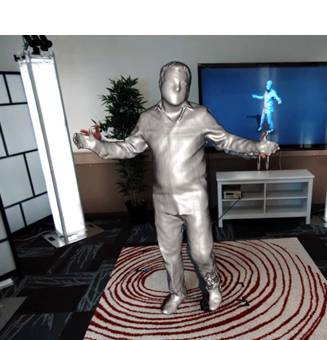| Holoportation - Another Step for Microsoft Research |
| Written by Sue Gee | |||
| Monday, 28 March 2016 | |||
|
This is the week in which the Hololens Developer Edition begins shipping and Microsoft Research has already taken another step into the future promised by this this technology with a demonstration of holoportation. According to the Microsoft Research Interactive 3D technologies team which is pioneering it: holoportation is a new type of 3D capture technology that allows high-quality 3D models of people to be reconstructed, compressed and transmitted anywhere in the world in real time. When combined with mixed reality displays such as HoloLens, this technology allows users to see, hear, and interact with remote participants in 3D as if they are actually present in the same physical space. Communicating and interacting with remote users becomes as natural as face-to-face communication. This video provides a state-of-the art demonstration and yes it does show that this is a worthwhile advance in communications technology.
Impressive though this is, it wasn't the first time we've had an opportunity to see holoportation. It was demoed "live" on stage at TED 2016 at the end of a talk by Alex Kipman, inventor of the HoloLens.
If you don't want to watch the whole talk, jump to around 11 minutes in where Kipman says: I invite you to experience, for the first time anywhere in the world, here on the TED stage, a real-life holographic teleportation, between me and my friend, Dr. Jeffrey Norris, from NASA's Jet Propulsion Laboratory. To the amazed delight of the audience, the demo works and we see Norris "land" on the stage. Asked where he is Norris claims to be in three places simultaneously, on the stage, a million miles away on the surface of Mars and in a room across the street. The bit that I find so convincing about this demo is what Norris then tells us about the potential of the technology. This is a precise holographic replica of Mars, built from data captured by the Curiosity Mars Rover, that I can explore as easily as a place on Earth. Humans are natural explorers. We can instantly understand an environment, just by being present in it. We've built tools like our Mars Rover to extend our vision and lengthen our reach. But for decades, we've explored from a seat behind screens and keyboards. Now, we're leaping over all of that, over the giant antennas and the relay satellites and the vastness between worlds to take our first steps on this landscape as if we were truly there. Today, a group of scientists on our mission are seeing Mars as never before -- an alien world made a little more familiar, because they're finally exploring it as humans should. NASA has been one of the early adopters of HoloLens technology, with two devices already shipped to the International Space Station as part of Sidekick, a collaborative project between Microsoft and NASA to provide virtual assistance from Earth to astronauts in space. So while the emphasis for the HoloLens Developer Edition is likely to be for gaming, there is certainly great potential for "serious" uses of this technology. As Kipman concludes his blog post: It’s thrilling to consider where technology might take us in a future that is closer than it seems. Microsoft has once again come up with a StarTrek-worthy glimpse into its mixed reality future. And the response that seems appropriate? It's teleportation Jim, but not as we know it!
More InformationHoloportation - Microsoft Research Microsoft HoloLens in space: Making science fiction (mixed) reality Related ArticlesHoloLens - Invitations To Pre-Order Starting Today Microsoft Hololens Development Edition Microsoft HoloLens For A Mixed Reality Future Microsoft's HoloLens - Not Holographic But Interesting
To be informed about new articles on I Programmer, sign up for our weekly newsletter, subscribe to the RSS feed and follow us on, Twitter, Facebook, Google+ or Linkedin.
Comments
or email your comment to: comments@i-programmer.info |
|||
| Last Updated ( Monday, 28 March 2016 ) |


